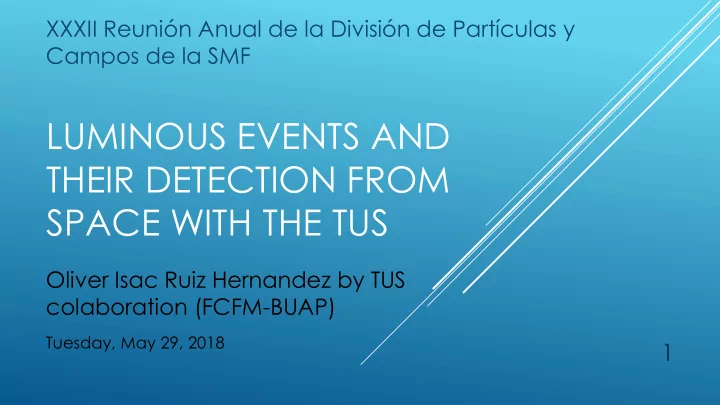

XXXII Reunión Anual de la División de Partículas y Campos de la SMF LUMINOUS EVENTS AND THEIR DETECTION FROM SPACE WITH THE TUS Oliver Isac Ruiz Hernandez by TUS colaboration (FCFM-BUAP) Tuesday, May 29, 2018 1
CONTENT ➢ The “ Lomonosov ” space project. ➢ TUS detector. ➢ Events selection. ❑ Selection process. ❑ Data reduction. ❑ Interesting events. ➢ Summary. 2
THE “LOMONOSOV” SPACE PROJECT The “Lomonosov” space project is lead by Lomonosov Moscow State University. Collaboration: Russia USA KOREA DENMARK SPAIN MEXICO Some of the principal goals of the experiment are to study: Ultra-high energy cosmic rays (UHECR) in the energy range of the o Greizen-Zatsepin-Kuzmin (GZK) cutoff. Ultraviolet (UV) transient luminous events in the upper atmosphere. o Multi wavelength study of gamma ray bursts in visible, UV, gamma o and X-rays [1] . 3 [1] Sadovnichy V. A., M. I. Panasyuk, A. M. Amelyushkin , et. al., “Lomonosov” Satellite -Space Observatory to Study Extreme Phenomena in Space. Space Sci. Rev. 212: 1705-1738, (2017).
Scientific Instruments Lomonosov carries a total of eight scientific payloads, including an ultraviolet detector and a telescope for measuring spectra and chemical composition of high-energy cosmic rays. Some of the scientific instruments are: ➢ BDRG: will be used to locate and monitor celestial sources of gamma radiation. ➢ ShOK: A pair of optical cameras for high-speed photography of light flashes, gamma-ray bursts, as well as satellites and space junk. ➢ UFFO: a X-ray camera and ultraviolet telescope. 4
TUS (TRACKING ULTRAVIOLET SET-UP) DETECTOR. The TUS detector on board the Lomonosov satellite consist of the following elements : ✓ Solar light sensor (SLS). ✓ Photodetector moving system (PDMS). ✓ Segmented mirror-concentrator (SMC). Photodetector (PD) [2] . ✓ 5 TUS detector on board the Lomonosov satellite [2] Klimov P. A., M. I. Panasyuk, B. A. Khrenov, et. al., The TUS detector of extreme energy cosmic rays on board the Lomonosov satellite. astro-ph.IM, arXiv: 1706.04976v2, (2017).
TUS (TRACKING ULTRAVIOLET SET-UP) DETECTOR. The TUS detector on board the Lomonosov satellite consist of the following elements : ✓ Solar light sensor (SLS). ✓ Photodetector moving system (PDMS). ✓ Segmented mirror-concentrator (SMC). Photodetector (PD) [2] . ✓ 6 TUS segmented mirror-concentrator [2] Klimov P. A., M. I. Panasyuk, B. A. Khrenov, et. al., The TUS detector of extreme energy cosmic rays on board the Lomonosov satellite. astro-ph.IM, arXiv: 1706.04976v2, (2017).
TUS (TRACKING ULTRAVIOLET SET-UP) DETECTOR. The TUS detector on board the Lomonosov satellite consist of the following elements : ✓ Solar light sensor (SLS). ✓ Photodetector moving system (PDMS). ✓ Segmented mirror-concentrator (SMC). Photodetector (PD) [2] . ✓ 7 The TUS photodetector (left) and one of the photodetector clusters (right) [2] Klimov P. A., M. I. Panasyuk, B. A. Khrenov, et. al., The TUS detector of extreme energy cosmic rays on board the Lomonosov satellite. astro-ph.IM, arXiv: 1706.04976v2, (2017).
Operational modes The sequence of waveforms is formed by the PDM (photodetector module) boards and provides four types of data (digital oscillograms, DOs) as an output: DO EAS, TLE-1, TLE-2 and METEOR, which correspond to the duration of three distinct physical processes in the atmosphere: extensive air showers, transient luminous events, and micro-meteors respectively. Temporal characteristics of different DO modes 8
EAS MODE The Earth´s atmosphere produce cascades of secondary particles, i.e. Extensive Air Showers (EAS), wich can provide information about the primary particle parameters. The bulk of secondary particles in EAS ionize and excite molecules of atmospheric nitrogen and oxygen and lead to the so-called ionization glow, which is most intensive along the EAS axis and resembles a track breacking out in a very short time (about several microseconds). The fluorescence intensity and its timing along the UV track provide information on EAS cascade developement, direction and energy of primary particles. 9
EVENTS SELECTION We analized data from the first semester of 2017, there were analized around 34,000 events, the selection of events was made with the help of custom made programs in Python and a further data reduction, which results in 220 interesting events. ❖ Selection process ➢ Selection by location. ➢ Selection by light background. ➢ Selection by signal to noise ratio. ❖ Data reduction Background correction. ➢ Gain correction. ➢ 10
Flow chart Location Yes Yes Generate No Light background No Signal to nosie ratio these Images Candidate 11 to event Not interesting Not interesting
Sample of the previous flow chart Sample of candidate to event 12
Corrected by Background and Gain correction Gain matrix Before correction After correction 13
Long track Preliminary Singulars Clasification Point like Middle track 14
Geographic distributions Point like events from March 2017 Point like events Middle events from April 2017 from April 2017 15
Long track event Interesting events 03-April-2017 16
Duration Distance Maximum Size Event (µs) Traveled Signal at frame 28 (km) (km 2 ) 16 4.8 1448.59 400 17
Point like event 18-April-2017 18
Duration Distance Maximum Size Event (µs) Traveled Signal at frame 18 (km) (km 2 ) 36.8 11.04 1408.98 150 19
Middle track event 20-April-2017 20
Duration Distance Maximum Size Event (µs) Traveled Signal at frame 32 (km) (km 2 ) 40 12 1053.69 400 21
SUMMARY We presented a brief scheme about the Lomonosov space project, and the TUS detector on board the Lomonosov satellite. We show the general scheme for events selection from TUS and discussed some results from events of the first semester of 2017 of the TUS on EAS operational mode, like a classification and geographic distribution. we are working on statistical analysis of the maximum value recorded on the event, as well as the analysis of the spatial extention of the interesting events. 22
GRACIAS POR SU ATENCIÓN 23
Recommend
More recommend